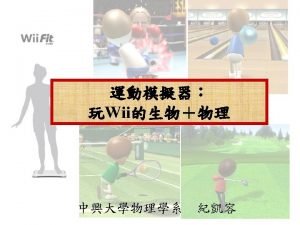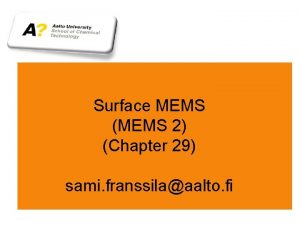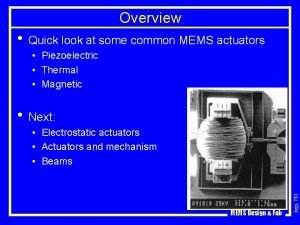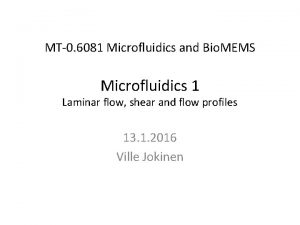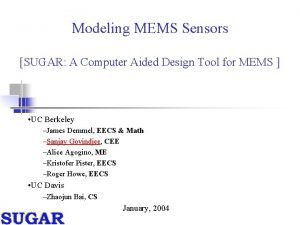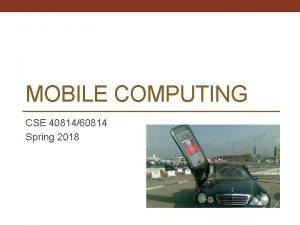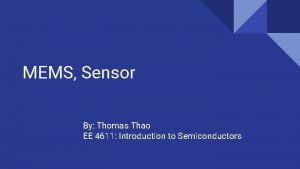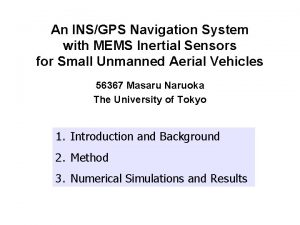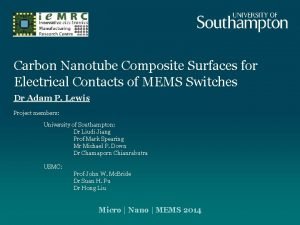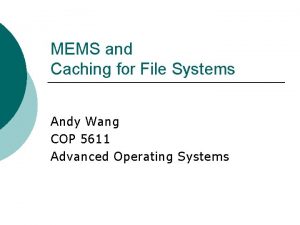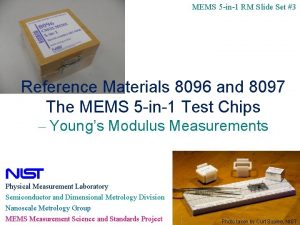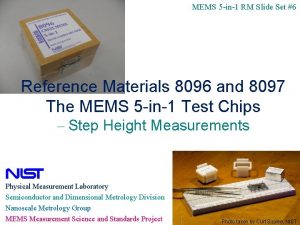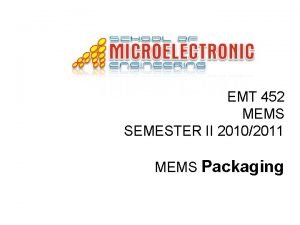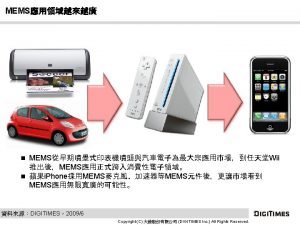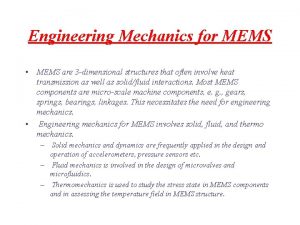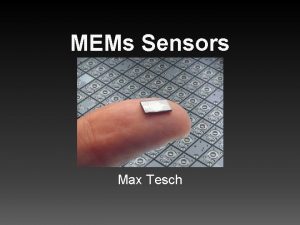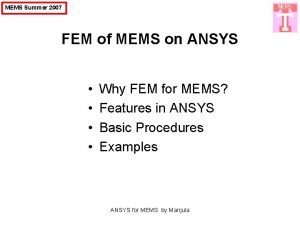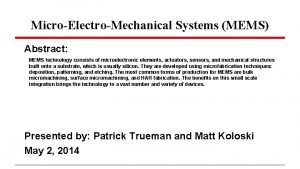MEMS 5 in1 RM Slide Set 8 Reference













- Slides: 13

MEMS 5 -in-1 RM Slide Set #8 Reference Materials 8096 and 8097 The MEMS 5 -in-1 Test Chips – Residual Stress and Stress Gradient Calculations Physical Measurement Laboratory Semiconductor and Dimensional Metrology Division Nanoscale Metrology Group MEMS Measurement Science and Standards Project 1 Photo taken by Curt Suplee, NIST

List of MEMS 5 -in-1 RM Slide Sets Slide Set # Title of Slide Set 1 OVERVIEW OF THE MEMS 5 -IN-1 RMs 2 PRELIMINARY DETAILS THE MEASUREMENTS: 11 3 Young’s modulus measurements 4 Residual strain measurements 5 Strain gradient measurements 6 Step height measurements 7 In-plane length measurements 8 Residual stress and stress gradient calculations 9 Thickness measurements (for RM 8096) 10 Thickness measurements (for RM 8097) REMAINING DETAILS 2

Outline for Residual Stress and Stress Gradient Calculations 1 References to consult 2 Residual stress and stress gradient a. Overview b. Equations used c. Data sheet uncertainty equations d. ROI uncertainty equation 3 Using the data sheet 4 Using the MEMS 5 -in-1 to verify measurements a. Residual stress b. Stress gradient 3

1. References to Consult • Overview 1. J. Cassard, J. Geist, and J. Kramar, “Reference Materials 8096 and 8097 – The Microelectromechanical Systems 5 -in-1 Reference Materials: Homogeneous and Stable, ” More. Than-Moore Issue of ECS Transactions, Vol. 61, May 2014. 2. J. Cassard, J. Geist, C. Mc. Gray, R. A. Allen, M. Afridi, B. Nablo, M. Gaitan, and D. G. Seiler, “The MEMS 5 -in-1 Test Chips (Reference Materials 8096 and 8097), ” Frontiers of Characterization and Metrology for Nanoelectronics: 2013, NIST, Gaithersburg, MD, March 25 -28, 2013, pp. 179182. 3. J. Cassard, J. Geist, M. Gaitan, and D. G. Seiler, “The MEMS 5 -in-1 Reference Materials (RM 8096 and 8097), ” Proceedings of the 2012 International Conference on Microelectronic Test Structures, ICMTS 2012, San Diego, CA, pp. 211 -216, March 21, 2012. • User’s guide (Section 7, pp. 132 -136) 4. J. M. Cassard, J. Geist, T. V. Vorburger, D. T. Read, M. Gaitan, and D. G. Seiler, “Standard Reference Materials: User’s Guide for RM 8096 and 8097: The MEMS 5 -in-1, 2013 Edition, ” NIST SP 260 -177, February 2013 (http: //dx. doi. org/10. 6028/NIST. SP. 260 -177). • Standard 5. SEMI MS 4 -1113, “Test Method for Young’s Modulus Measurements of Thin, Reflecting Films Based on the Frequency of Beams in Resonance, ” November 2013. (Visit http: //www. semi. org for ordering information. ) • Fabrication 6. The RM 8096 chips were fabricated through MOSIS on the 1. 5 µm On Semiconductor (formerly AMIS) CMOS process. The URL for the MOSIS website is http: //www. mosis. com. The bulkmicromachining was performed at NIST. 7. The RM 8097 chips were fabricated at MEMSCAP using MUMPs-Plus! (Poly. MUMPs with a 4 backside etch). The URL for the MEMSCAP website is http: //www. memscap. com.

2 a. Residual Stress/Stress Gradient Overview Residual Stress • Definition: The remaining force per unit area within a layer after the original cause(s) during fabrication have been removed yet before the constraint of the sacrificial layer is removed Purpose: To improve the yield in CMOS fabrication processes since high values of residual stress can lead to failure mechanisms in ICs Method: Calculated given Young’s modulus and residual strain • • Stress Gradient • Definition: The through-thickness variation (of the residual stress) in • • the layer before it is released Purpose: To measure through-thickness variation of the residual stress in the structural layer of interest before it is released Method: Calculated given Young’s modulus and strain gradient 5

2 b. Residual Stress Equation where r E r Residual Stress σr = E ε r residual stress Young’s modulus residual strain Effective value reported? (RM 8096) Effective value reported? (RM 8097) E Yes a) debris in corners b) undercutting c) composite oxide Yes a) kinks b) undercutting c) non-rigid support εr Yes a) debris in corners b) undercutting c) composite oxide Yes a) kinks b) undercutting c) non-rigid support yes 6

2 b. Stress Gradient Equation where g E sg Stress Gradient σg = E s g stress gradient Young’s modulus strain gradient Effective value reported? (RM 8096) Effective value reported? (RM 8097) E Yes a) debris in corners b) undercutting c) composite oxide Yes a) kinks b) undercutting c) non-rigid support sg Yes a) excessive curvature b) composite oxide No yes 7

2 c. Data Sheet Uncertainty Equation for Residual Stress where uc r uc. E uc r residual stress combined standard uncertainty Young’s modulus combined standard uncertainty residual strain combined standard uncertainty • The data sheet (DS) expanded uncertainty equation where k=2 is used to approximate a 95 % level of confidence. 8

2 c. Data Sheet Uncertainty Equation for Stress Gradient where uc g uc. E ucsg stress gradient combined standard uncertainty Young’s modulus combined standard uncertainty strain gradient combined standard uncertainty • The data sheet (DS) expanded uncertainty equation is where k=2 is used to approximate a 95 % level of confidence. 9

2 d. ROI Uncertainty Equation UROI UDS Ustability expanded uncertainty recorded on the Report of Investigation (ROI) expanded uncertainty as obtained from the data sheet (DS) stability expanded uncertainty 10

3. Using the Data Sheet • Find Data Sheet YM. 3 – On the MEMS Calculator website (Standard Reference Database 166) accessible via the NIST Data Gateway (http: //srdata. nist. gov/gateway/) with the keyword “MEMS Calculator” Note the symbol next to this data sheet. This symbol denotes items used with the MEMS 5 -in-1 RMs. – • Using Data Sheet YM. 3 – – Click “Reset this form” Supply INPUTS to Tables 1, 2, and 4 • • – – r and uc r are found using Data Sheet RS. 3 sg and ucsg are found using Data Sheet SG. 3 Click “Calculate and Verify” At the bottom of the data sheet, make sure all the pertinent boxes say “ok. ” If a pertinent box says “wait, ” address the issue and “recalculate. ” Residual stress and stress gradient OUTPUTS given in Table 7 Compare both the inputs and outputs with the NIST-supplied values 11

4 a. Using the MEMS 5 -in-1 To Verify Residual Stress Measurements • If your criterion for acceptance is: where D r U r(customer) U r positive difference between the residual stress value of the customer, r(customer), and that appearing on the ROI, r residual stress expanded uncertainty of the customer residual stress expanded uncertainty on the ROI, UROI • Then can assume measuring residual stress according to SEMI MS 4 according to your criterion for acceptance if: – Criteria above satisfied and 12 – No pertinent “wait” statements at the bottom of your Data Sheet YM. 3

4 b. Using the MEMS 5 -in-1 To Verify Stress Gradient Measurements • If your criterion for acceptance is: where D g U g(customer) U g positive difference between the stress gradient value of the customer, g(customer), and that appearing on the ROI, g stress gradient expanded uncertainty of the customer stress gradient expanded uncertainty on the ROI, UROI • Then can assume measuring stress gradient according to SEMI MS 4 according to your criterion for acceptance if: – Criteria above satisfied and 13 – No pertinent “wait” statements at the bottom of your Data Sheet YM. 3



